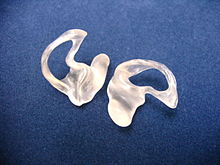Earmold
Under otoplastic (from the Greek ous , genitive OTos , " ear " and plastein "forms, shapes") refers to the production of molded fittings for example, hearing aids or hearing protection by the hearing care professional . The term is used both for the manufacturing process and for the finished product. In addition, a cosmetic operation on the ear, for example the reconstruction of an auricle damaged by accident or illness, can also be referred to as an otoplasty .
This article covers the manufacture of molded fittings.
Manufacturing
Since the shape of the ears and the auditory canals differs from person to person, an individual molding of the ear is the basis for the production of the otoplastic. First, after an otoscopic examination and, if necessary, cleaning of the ear (by an ENT doctor), a cotton umbrella or foam ball (tamponade) is inserted on a fine cord into the bony part of the external auditory canal. This protects the eardrum and prevents the still soft impression material from flowing deeper into the ear canal, touching the eardrum and possibly injuring it.
Then the auditory canal and the areas of the ear required for the otoplasty are molded with addition- curing silicone material . This material hardens in a few minutes (depending on the material and temperature) and forms a positive impression of the ear, which the hearing aid acoustician serves as a template for the production of the otoplastic.
The impression taking is painless and unproblematic if carried out correctly.
In the further course of production, this ear impression can be taken with a 3D scanner and processed on the computer. According to this template, a large number of extremely thin plastic layers are then placed on top of one another during the production process and cured under UV light. Today, this process is used almost exclusively in the manufacture of shells for in-the-ear hearing systems, because the smallest possible shell size for the ear to be treated can be determined on the computer so that the technology to be accommodated just fits in.
On the other hand, it is possible to produce a negative impression of the ear from silicone or agar-agar from the ear impression . This template of the actual ear can then be filled with the desired material.
To complete the manufacturing process, it is necessary to process the blank by hand ( milling , polishing, painting, etc.).
Typical areas of application for earmolds
There are essentially four typical areas of application for otoplastics:
Hearing aids
Hearing aids (colloquially hearing aids , in advertising language hearing systems ) that are worn by the affected person for many hours a day require the earmolds to be precisely adapted to the individual ear in order to seal the ear - if necessary - to ensure that the hearing aid is held securely on the ear and to offer the necessary comfort.
ear protection

Custom-made otoplastics are often considerably superior to non-custom-made ear plugs (known colloquially under the brand name Ohropax ) in terms of comfort and protection. In particular, the option of inserting replaceable filter capsules in the earmolds enables individually adapted noise reduction. In addition, the filters often offer a relatively unchanged frequency response. This is especially recommended for musicians, music lovers and people for whom a good understanding of speech is in the foreground (e.g. pilots), since music and speech can be perceived unadulterated when using such a filter. In the case of a non-linear insulation curve, as shown by many products made of foam, the ambient noises sound dull and unclear because the high frequencies are usually shielded more strongly in relation to the low frequencies.
In addition to noise, hearing protection can also be used to protect against water and dirt entering the ear (see: Hearing Protection ).
In-ear monitoring headphones
The design of complete miniature headphones as otoplastics enables headphones to be worn inconspicuously in situations where conventional capsule headphones are not appropriate for reasons of appearance or discretion. This can be the proverbial button in the ear , such as for reporters, moderators and security forces, or the so-called " In-Ear Monitoring " (IEM) for musicians who have an individually mixed audio signal at a relatively moderate volume is provided. In this case, the in-ear headphones also serve as protection against the sometimes considerable volume levels on stage.
Jewelry earmold
In bright colors, decorated with rhinestones and figures or milled in unusual shapes, an otoplastic can also serve as a piece of jewelry on the ear. Depending on your needs, the ear canal can be open or closed so that the piece of jewelery can be used as hearing protection at the same time, and it can also serve as an extraordinary piece of jewelery on the ear, for example for visiting discos.
materials
The materials used are usually plastics such as acrylic or silicone in different mixtures and degrees of hardness, which are selected depending on the intended use. In the case of allergies to the plastics normally used, earmolds are also glazed or gold-plated or allergen-free plastics such as Neutacryl, Thermotec etc. are selected.
swell
- Peter Plath: The hearing organ and its function: an introduction to audiometry . Berlin 1992, ISBN 3-89166-151-7 , Das Ohrpaßstück, p. 161 f .
Web links
- Hearing aids - Infothek of the Hörkomm.de project - Barrier-free hearing and communication in the working world





